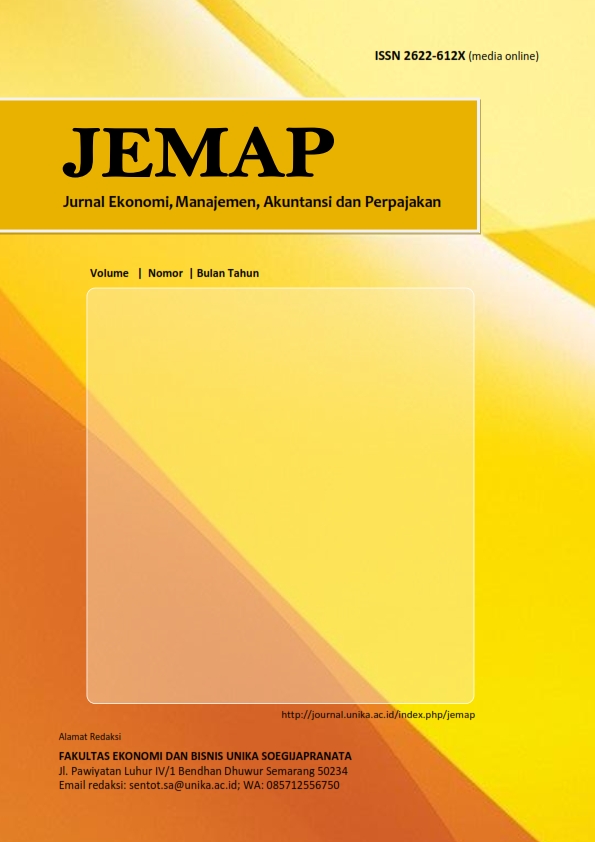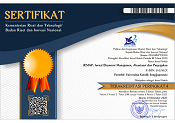Peran Dimensi Motivasi Pelayanan Publik Dalam Meningkatkan Komitmen Afektif Pegawai
Abstract
Organizational commitment is considered as one of the most important results of public service motivation. There is also an important literature from management studies and organizational behavior that emphasizes affective commitment as the main component of organizational commitment. Based on that, the purpose of this study is to examine the role of the dimensions of public service motivation on employee affective commitment. By using a quantitative approach, the research model was built and tested on 179 research respondents, who were public officer work in the area of Bandung, West Java. Multiple regression analysis is used to analyze the data, with the criteria valid for validity and reliability test. The findings showed that of the four dimensions of public service motivation, it was found that only two significantly affected affective commitment, which were variable commitment to the public interest and variable compassion.
Keywords
Full Text:
PDF (Bahasa Indonesia)References
Amegavi, G. B., & Mensah, J. K. (2020). Commitment to public interest and public service motivation development challenges: A qualitative inquiry. Public Administration Issues, 6(II), 67–83. https://doi.org/10.17323/1999-5431-2020-0-6-67-83
Austen, A., & Zacny, B. (2015). The role of public service motivation and organizational culture for organizational commitment. Management, 19(2), 1–14. https://doi.org/10.1515/manment-2015-0012
Boruvka, E., & Perry, J. L. (2020). Understanding evolving public motivational practices: An institutional analysis. Governance, 33(3), 565–584. https://doi.org/10.1111/gove.12460
Christensen, R. K., Paarlberg, L., & Perry, J. L. (2017). Public service motivation research: Lessons for practice. Public Administration Review, 77(4), 529–542. https://doi.org/10.1111/puar.12796
Crewson, P. E. (1997). Public-service motivation: Building empirical evidence of incidence and effect. Journal of Public Administration Research and Theory, 7(4), 499–518. https://doi.org/10.1093/oxfordjournals.jpart.a024363
Culpepper, R. A. (2000). A test of revised scales for the Meyer and Allen (1991) three-component commitment construct. Educational and Psychological Measurement, 60(4), 604–616. https://doi.org/10.1177/00131640021970754
Eby, L. T., Freeman, D. M., Rush, M. C., & Lance, C. E. (1999). Motivational bases of affective organizational commitment: A partial test of an integrative theoretical model. Journal of Occupational and Organizational Psychology, 72(4), 463–483. https://doi.org/10.1348/096317999166798
Feather, N. T., & Rauter, K. A. (2004). Organizational citizenship behaviours in relation to job status, job insecurity, organizational commitment and identification, job satisfaction and work values. Journal of Occupational and Organizational Psychology, 77(1), 81–94. https://doi.org/10.1348/096317904322915928
Guswandi, G., Nursyamsi, I., Sumardi, S., & Hardiyono, H. (2020). Improving performance: Motivation of public service officers and their commitment. Hasanuddin Journal of Business Strategy, 2(2), 51–56. https://doi.org/10.26487/hjbs.v2i2.332
Harari, M. B., Herst, D. E. L., Parola, H. R., & Carmona, B. P. (2017). Organizational correlates of public service motivation: A meta-analysis of two decades of empirical research. Journal of Public Administration Research and Theory, 27(1), 68–84. https://doi.org/10.1093/jopart/muw056
Herscovitch, L., & Meyer, J. P. (2002). Commitment to organizational change: Extension of a three-component model. Journal of Applied Psychology, 87(3), 474–487. https://doi.org/10.1037/0021-9010.87.3.474
Hidayati, N., & Sunaryo, H. (2019). The effect of public service motivation on job performance through satisfaction and commitment: case of public officer in immigration office malang. Journal of Entrepreneurship, Business and Economics, 7(1), 1–16.
Jin, M. H., McDonald, B., & Park, J. (2018). Does public service motivation matter in public higher education? Testing the theories of person–organization fit and organizational commitment through a serial multiple mediation model. American Review of Public Administration, 48(1), 82–97. https://doi.org/10.1177/0275074016652243
Kjeldsen, A., & Jacobsen, C. (2013). Public service motivation and employment sector: Attraction or socialization? Journal of Public Administration Research and Theory, 23, 899–926.
Mathieu, J. E., & Zajac, D. M. (1990). A Review and meta-analysis of the antecedents, correlates, and consequences of organizational commitment. Psychological Bulletin, 108(2), 171–194. https://doi.org/10.1037/0033-2909.108.2.171
Mercurio, Z. A. (2015). Affective commitment as a core essence of organizational commitment: An integrative literature review. Human Resource Development Review, 14(4), 389–414. https://doi.org/10.1177/1534484315603612
Meyer, J. P., & Allen, N. J. (1997). Commitment in the workplace : Theory, research, and application. SAGE.
N. Allen, & J. Meyer. (1990). The measurement and antecedents of affective, continuance and normative commitment to the organization. Journal of Occupational Psychology, 63, 1–18.
Pandey, S. K., & Wright, B. E. (2006). Connecting the dots in public management: Political environment, organizational goal ambiguity, and the public manager’s role ambiguity. Journal of Public Administration Research and Theory, 16(4), 511–532. https://doi.org/10.1093/jopart/muj006
Perry, J. L. (1996). Measuring public service motivation: An assessment of construct reliability and validity. Journal of Public Administration Research and Theory, 6(1), 5–22. https://doi.org/10.1093/oxfordjournals.jpart.a024303
Perry, J. L., Hondeghem, A., & Wise, L. R. (2010). Revisiting the motivational bases of public service : Twenty years of research and an agenda for the future symposium. Public Administration Review, 70(5), 681–690. https://doi.org/10.3892/ijmm.8.5.549
Perry, J. L., Mesch, D., & Paarlberg, L. (2006). Motivating employees in a new era : The performance paradigm revisited. Public Administration Review, 66(4), 505–514.
Perry, J. L., & Wise, L. R. (1990). The motivational bases of public service. Public Administration Review, 50(3), 367–373. https://doi.org/10.1111/j.1540-6210.2005.00466.x
Porter, L. W., Steers, R. M., Mowday, R. T., & Boulian, P. V. (1974). Organizational commitment, job satisfaction, and turnover among psychiatric technicians. Journal of Applied Psychology, 59(5), 603–609. https://doi.org/10.1037/h0037335
Potipiroon, W., & Ford, M. T. (2017). Does public service motivation always lead to organizational commitment? Examining the moderating roles of intrinsic motivation and ethical leadership. Public Personnel Management, 46(3), 1–28. https://doi.org/10.1177/0091026017717241
Pradesa, H. A. (2018). Peran komitmen afektif dalam memperkuat dampak dari dimensi iklim kerja etis terhadap perasaaan berkewajiban pegawai negeri sipil di kantor pemerintahan provinsi jawa barat. Jurnal Ilmiah Bisnis dan Ekonomi Asia, 12(2), 16–29.
Pradesa, H. A., Dawud, J., & Affandi, M. N. (2019). Mediating role of affective commitment in the effect of ethical work climate on felt obligation among public officers. JEMA: Jurnal Ilmiah Bidang Akuntansi dan Manajemen, 16(2), 133–146. https://doi.org/10.31106/jema.v16i2.2707
Pratama, A. B., & Nurhidayah, A. (2019). Does public service motivation matter to employees’ performance and organizational commitment in sub-district offices? JKAP: Jurnal Kebijakan Dan Administrasi Publik, 23(1), 1–15. https://doi.org/10.22146/jkap.37913
Putranto, R. A., Setiajatnika, E., & Fahmi, I. (2018). The effect of public service motivation and job satisfaction on public officers’ performance through commitment. International Journal of Academic Research in Business and Social Sciences, 8(12), 1422–1435. https://doi.org/10.6007/ijarbss/v8-i12/5247
Rainey, H. G. (1982). Reward preferences among public and private managers: In search of the service ethic. The American Review of Public Administration, 16(4), 288–302.
Stazyk, E. C., Pandey, S. K., & Wright, B. E. (2011). Understanding affective organizational commitment: The importance of institutional context. American Review of Public Administration, 41(6), 603–624. https://doi.org/10.1177/0275074011398119
Supriatna, M. D., Pradesa, H. A., & Priatna, R. (2019). Literature review and conceptual models development on public services motivation. Warmadewa Management and Business Journal (WMBJ) Agustus, 1(2), 102–110. https://ejournal.warmadewa.ac.id/index.php/wmbj
Widarni, E. L., & Irawan, C. B. (2020). Analisis motivasi pelayanan publik dan role stress terahdap kinerja pegawai dengan komitmen organisasi sebagai variabel intervening pada PT Kereta Api Indonesia DAOP VIII. Dinamika Governance : Jurnal Ilmu Administrasi Negara, 10(2), 120–134.
DOI: https://doi.org/10.24167/jemap.v4i2.3237
Refbacks
- There are currently no refbacks.
e-ISSN 2622-612X | View My Stats







